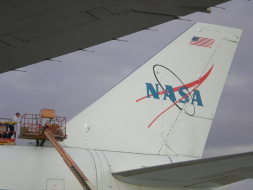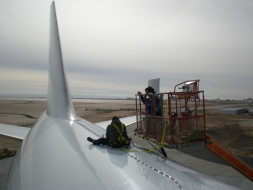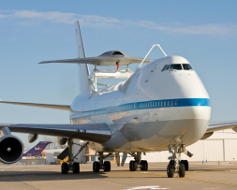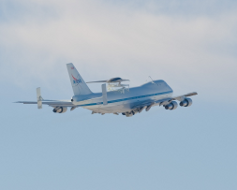In December, 2010, Boeing's Phantom Works group transported their Phantom Ray (PR) unmanned aircraft from St. Louis to the Dryden Flight Research Center for initial flight testing.
To do this, Boeing arranged to use NASA's 747 Shuttle Carrier Aircraft (SCA).
The NASA Engineering & Safety Center (NESC) was responsible for investigating the possibility that the wake from the PR and its attachment structure would generate unacceptable aeroelastic motion in the SCA's empennage.
Initially, NEAR worked with NESC to investigate this problem analytically.
While analysis was able to determine that some flexural modes (i.e., bending) would not be problematic, the analysis was not able to support any conclusion for the torsional modes.
NEAR was then tasked with developing an instrumentation system that could measure pressure and acceleration levels on the SCA's vertical and horizontal tail in flight.
NEAR designed, fabricated, and installed the system on the SCA at Dryden as shown in the photographs below.
Baseline pressure and acceleration data were collected for the SCA without the PR attached during a ferry flight from Dryden to St. Louis.
Once in St. Louis, NASA and Boeing personnel mounted the PR onto the SCA, and conducted a 2-hour test flight around the St. Louis airport.
During this flight NEAR collected a second set of pressure and acceleration data.
This latter set of data were compared to the baseline data using time-domain analysis (rms and cross correlation) and frequency-domain analysis (power spectral density).
These analyses indicated that there was no appreciable aeroelastic coupling between the PR wake and the SCA empennage, and the flight to Dryden was allowed to proceed.
For this effort, NEAR received NESC's Group Achievement Award, and Daniel Pruzan (Vice-President/Director of Engineering at NEAR) received the NESC Leadership Award.

Running cables from the 6 pressure sensor/accelerometer pairs on the vertical tail.

Running cables from all 12 sensor pairs to the "pass-through" hole in the fuselage.

Phantom Ray attached to the SCA.

Flight test around the St. Louis airport.





